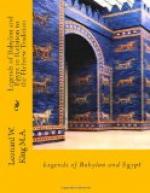(1) See Breasted, Zeitschrift
fur Aegyptische Sprache,
XXXIX, pp. 39 ff., and
History of Egypt, pp. 356 ff.
This series of sculptures shared the deliberate mutilation that all her records suffered at the hands of Thothmes III after her death, but enough of the scenes and their accompanying text has survived to render the detailed interpretation of the myth quite certain.(1) Here, as in a general Creation myth, Amen’s first act is to summon the great gods in council, in order to announce to them the future birth of the great princess. Of the twelve gods who attend, the first is Menthu, a form of the Sun-god and closely associated with Amen.(2) But the second deity is Atum, the great god of Heliopolis, and he is followed by his cycle of deities—Shu, “the son of Ra”; Tefnut, “the Lady of the sky”; Keb, “the Father of the Gods”; Nut, “the Mother of the Gods”; Osiris, Isis, Nephthys, Set, Horus, and Hathor. We are here in the presence of cosmic deities, as befits a projected act of creation. The subsequent scenes exhibit the Egyptian’s literal interpretation of the myth, which necessitates the god’s bodily presence and personal participation. Thoth mentions to Amen the name of queen Aahmes as the future mother of Hatshepsut, and we later see Amen himself, in the form of her husband, Aa-kheperka-Ra (Thothmes I), sitting with Aahmes and giving her the Ankh, or sign of Life, which she receives in her hand and inhales through her nostrils.(3) God and queen are seated on thrones above a couch, and are supported by two goddesses. After leaving the queen, Amen calls on Khnum or Khnemu, the flat-horned ram-god, who in texts of all periods is referred to as the “builder” of gods and men;(4) and he instructs him to create the body of his future daughter and that of her Ka, or “double”, which would be united to her from birth.




